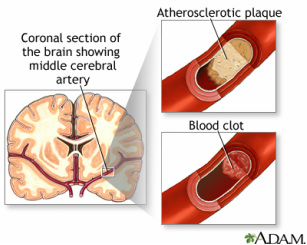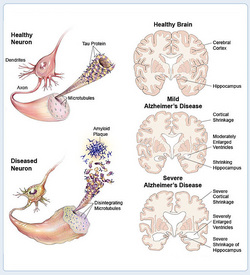HIRUDOTHERAPY IN THE TREATMENT OF BILATERAL INTERNAL CAROTID ARTERY OCCLUSION: CASE REPORT
[from UDC 616.133-08 Curr Top Neurol...Vol 18, September 2010]

ISCHEMIC STROKE
Ischemic stroke occurs when a blood vessel that supplies blood to the brain is blocked by a blood clot. This may happen in two ways:
1. A clot may form in an artery that is already very narrow. This is called a thrombotic stroke.
2. A clot may break off from another place in the blood vessels of the brain and travel up to the brain. This is called an embolic stroke; OR: be caused by blood clots that form in the heart or other parts of the body. These clots travel through the blood and can get stuck in the small arteries of the brain. This is known as a cerebral embolism.
HEMORRHAGIC STROKE
A hemorrhagic stroke occurs when a blood vessel in part of the brain becomes weak and bursts open, causing blood to leak into the brain. Some people have defects in the blood vessels of the brain that make this more likely.
Abstract:
We present a case of a 67-year-old man, who had two ischemic strokes, first with a right hemiparesis and sensory aphasia, second with signs of brain stem damage. Magnetic resonance angiography and ultrasonography confirrmed bilateral occlusion of internal carotid arteries. Computed tomography revealed multiple ischemic lesions of the brain. Having had contraindications for aspirin due to duodenal ulcer, the patient was initially and afterwards regularly treated with hirudotherapy. His general medical condition was later stable, while neurological deficit almost completely improved.
....Read more
===================================
How the Brain and Nerve Cells Change During
Alzheimer's Disease

One of the hallmarks of Alzheimer's disease is the accumulation of amyloid plaques between nerve cells (neurons) in the brain. Amyloid is a general term for protein fragments that the body produces normally. Beta amyloid is a fragment of a protein snipped from another protein called amyloid precursor protein (APP). In a healthy brain, these protein fragments would break down and be eliminated. In Alzheimer's disease, the fragments accumulate to form hard, insoluble plaques.
Hirudosubstances allow to stimulate growth of neurons and their neurodendrons,
HOPE for PARKINSON'S DISEASE, MS/MD and Alzheimer's!
THE REGENERATION OF THE NERVUOS SYSTEM- Nerve and Brain cells!! [research studies conclusion].
===================================================================================
HOPE for PARKINSON'S DISEASE, MS/MD and Alzheimer's!
THE REGENERATION OF THE NERVUOS SYSTEM- Nerve and Brain cells!! [research studies conclusion].
===================================================================================
Effect of Leeches Therapy in Periarticular Symptoms
of Rheumatoid Arthritis and Osteoarthritis
Abstract: Effect of Leeches Therapy in Periarticular Symptoms of Rheumatoid Arthritis and Osteoarthritis
by I. G. Salikhov, S. A. Lapshina1, D. I. Salikhova1, R. G. Mukhina, R. A. Khabirov1, R. Z. Abdrakipov, F. H. Latfullina
Background: Complex clinical and instrumental investigations (kinesthesical method, thermovision, ultrasonography) showed significant involvement (up to 69%) of periarticular structures (muscles, tendons) in rheumatoid arthritis (RA) and osteoarthritis (OA) aggravating the clinical picture of the disease and leading to the decrease of life quality of the patients. The substrate of myofascial pain syndrome are local densities in muscular tissue and in the places of detachment of tendons to the bones.
Objectives: The goal of our study was to evaluate the effect of leeches therapy (hirudotherapy) in treatment of RA and OA with muscular syndrome.
Methods: 105 patients with local densities in muscular tissue (54 with RA and 51 with OA) were enrolled and assessed before and after therapy of leeches. The efficacy of therapy was estimated by Lee and Reachy indices of muscular syndrome, duration of early morning stiffness and the range of active and passive movements of joints.
We did hirudotherapy from1 to 5 times to each patient (4-20 Hirudo medicinalis for course) using leeches on the area of painful trigger zones in the muscles surrounding the joints.
Results: We found in all patients clinical improvement after leeches therapy which included decrease or disappearance of myalgias and arthralgias, duration of early morning stiffness. Also the range of movements in joints increased as well as functional activity of patients improved. Laboratory tests showed changes - decrease of erythrocyte sedimentation rate, C reactive protein, sialic acid, prothrombin index (PTI), activated partial thromboplastin time (APTT) and prolongation of coagulation time. No significant side effects after treatment of leeches were found.
Conclusion: The using of leeches for local therapy of myofascial pain syndrome are effective and safe in patients with RA and OA.
Reprinted from:
http://www.arthritissupport.com/library/showarticle.cfm/ID/407/T/Arthritis
